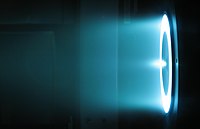Electrically powered spacecraft propulsion

Imagine you are sitting in a toy car and you need to push it to move forward. Now imagine the car has an electric motor that helps it move without you having to push it. This is how electrically powered spacecraft propulsion works.
Instead of using fuel like traditional spacecraft, electrically powered spacecraft use a form of electricity to propel them forward. This type of electricity is generated using solar panels or small nuclear reactors on board the spacecraft. The electricity is stored in batteries and then used to power an electric motor that creates a force to move the spacecraft forward.
The great thing about electrically powered spacecraft is that they are more efficient than traditional spacecraft. This means they can travel further and faster using less energy. They are also more reliable because there are fewer moving parts that can break down.
The downside is that electrically powered spacecraft must be in space to generate electricity using solar power. They also have a slower acceleration than traditional spacecraft, which means they take longer to get up to speed. However, once they are up to speed, they can travel for a long time without requiring additional fuel.
In summary, electrically powered spacecraft use electricity generated from solar panels or nuclear reactors to power an electric motor and move the spacecraft forward. They are more efficient and reliable than traditional spacecraft but have a slower acceleration and require solar power or nuclear power to generate electricity.
Instead of using fuel like traditional spacecraft, electrically powered spacecraft use a form of electricity to propel them forward. This type of electricity is generated using solar panels or small nuclear reactors on board the spacecraft. The electricity is stored in batteries and then used to power an electric motor that creates a force to move the spacecraft forward.
The great thing about electrically powered spacecraft is that they are more efficient than traditional spacecraft. This means they can travel further and faster using less energy. They are also more reliable because there are fewer moving parts that can break down.
The downside is that electrically powered spacecraft must be in space to generate electricity using solar power. They also have a slower acceleration than traditional spacecraft, which means they take longer to get up to speed. However, once they are up to speed, they can travel for a long time without requiring additional fuel.
In summary, electrically powered spacecraft use electricity generated from solar panels or nuclear reactors to power an electric motor and move the spacecraft forward. They are more efficient and reliable than traditional spacecraft but have a slower acceleration and require solar power or nuclear power to generate electricity.
Related topics others have asked about:
